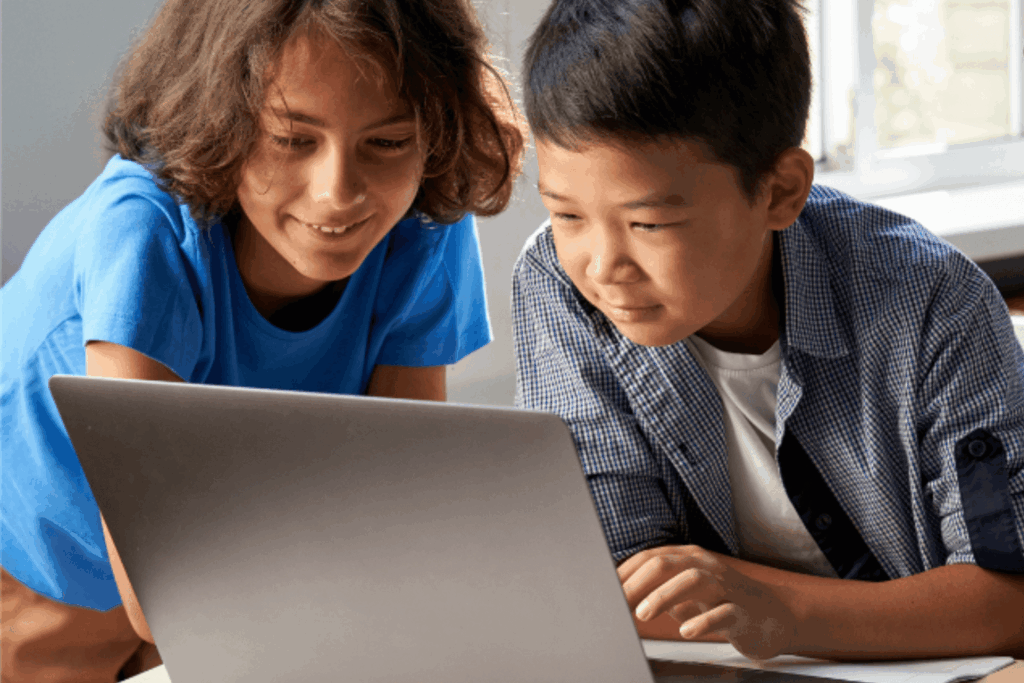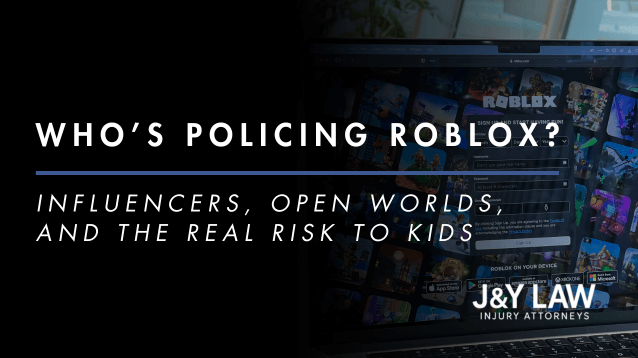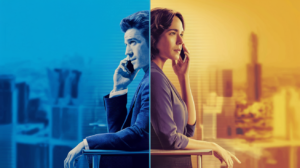Who’s Policing Roblox? Influencers, Open Worlds, and the Real Risk to Kids
If you think Roblox is just a kids’ game, think again. It’s become a vast digital world where players build, explore, and connect with friends. Sometimes though, they connect with strangers.
With more than 111 million people logging in daily and around 40% of players under 13, Roblox is one of the most influential platforms for children today.
But as this “kids’ game” has grown into a billion-dollar ecosystem, new concerns have surfaced. Parents are asking: why are adults even allowed to play alongside children? Who monitors the open-world environments? And what happens when adult influencers speak directly to kids, often without clear oversight?
At J&Y Law, from schools to video games – we take child safety seriously. Below, we break down what parents need to know about the risks on Roblox, what red flags to look out for, and the privacy protections you can put in place today to help keep your child safe.
Why Do Adults Play Roblox If It’s Marketed To Kids?
Roblox markets itself as an “all-ages” platform. Unlike some children’s games that restrict accounts to under-13s, Roblox allows anyone to sign up, play, and even create experiences. That openness is part of its appeal: kids can play alongside teens, parents, and older siblings.
But openness comes with a cost. When adults and children share digital space without strict separation, it creates opportunities for abuse. Grooming behaviors like building trust, isolating victims, and moving conversations off-platform become harder to monitor.
Roblox’s own filings show the scale of the challenge. In 2024, Roblox reported 24,522 child-exploitation incidents to the National Center for Missing and Exploited Children (NCMEC).
“Just because a platform looks like it’s built for kids doesn’t mean it’s safe for kids,” says Alex Boris, Senior Trial Attorney at J&Y Law. “We’ve seen too many cases, whether it’s online and in schools, where that illusion of safety gave predators cover. When adults and children share unmoderated digital space, it’s a recipe for quiet harm.”
For a free legal consultation, call (424) 453-2310
Who Is Actually Policing Roblox’s Open Worlds?
Roblox relies heavily on technology for player safety.
- AI moderation tools scan billions of messages and uploads for grooming signals, inappropriate content, or banned keywords.
- In 2025, Roblox launched Sentinel, a system designed to identify grooming patterns across chat logs. In its first six months, Sentinel helped flag 1,200 exploitation reports to NCMEC.
- Roblox also employs thousands of human moderators to review flagged content.
Despite these efforts, watchdogs and researchers still find gaps. A 2025 report called Roblox “deeply disturbing” for children, citing instances where kids could access inappropriate environments or interact with adults despite safeguards.
In truth, no moderation system can monitor every interaction in real time across a platform this size. Parents still need to play an active role.
Does Roblox Normalize Dangerous Themes For Kids?
One of the most troubling aspects parents need to know is the culture of language and themes within Roblox itself. Some of the most popular experiences use terms that, to adults, read as red flags.
For example, phrases like “admin abuse” – used in games such as Grow a Garden, one of the most popular games on Roblox right now – make it seem like abusing power is normal, even funny. Then there are horror-based games where the goal is to “Survive the Night” against a serial killer. In Roblox, your character respawns. In real life, consequences aren’t so forgiving.
These aren’t just storylines. This type of gameplay normalizes deviant behavior. When abuse of power, lying, and stealing are treated as entertainment, it creates a culture where predators feel comfortable blending in. Kids begin to see deception not as a problem, but as part of the “fun.”
Let’s look closer at Grow a Garden. On the surface, it’s a simple farming simulator where players grow plants, collect items, and decorate their gardens. But because any player can message another, there’s a thriving culture of trades, exchanges, and private deals. “Scamming” is practically expected: a player offers a trade, accepts an item, and then vanishes without giving their side of the bargain. The game doesn’t just allow it—it’s normalized through repetition and shared jokes. Children quickly learn that tricking others for gain is part of the game.

Steal a Brainrot is another trending Roblox title. The very name tells you what’s inside. A “brainrot” is a term young players use to describe obsessive, low-value content that clogs up their feeds and conversations. In this game, stealing is the central mechanic. Players are encouraged to deceive one another, snatch items, and celebrate the act of taking from someone else. What begins as a silly challenge reinforces the idea that dishonesty is entertainment.
Then there are the games that regularly appear on “most restricted” or “not safe for kids” lists. Titles like Raise a Floppa have gained notoriety because they sometimes smuggle in inappropriate memes, political messages, or disturbing images. While the surface gameplay – caring for a pixelated cat – is innocent, the hidden layers are what concern parents. These experiences thrive on shock value, slipping in content that skirts moderation and normalizes exposure to adult themes.
Because any player can interact with any other player unless strict parental settings are applied, kids may be approached by strangers. Through trades, chats, or in-game collaborations, conversations can quickly shift into areas parents aren’t prepared form, or even aware of. What starts as a harmless game about gardening can lead to private conversations about exclusive items or connections outside the platform.
As a parent, these are the things you must be thinking about. Understanding the risks, recognizing cultural cues, and putting privacy protections in place today can make all the difference.
Click to contact our personal injury lawyers today
What Are Roblox Influencers Teaching Our Kids?
If your child plays Roblox, chances are they also watch Roblox content creators. Influencers on YouTube, Twitch, and TikTok showcase Roblox games, tutorials, and live streams. Some even partner directly with Roblox through the Video Stars Program.
Here’s the concern: children trust influencers as if they’re friends. But these influencers are almost always adults, speaking directly to under-13 audiences.
In 2022, the Children’s Advertising Review Unit (CARU) found Roblox in violation of advertising guidelines because it didn’t ensure clear ad disclosures for kids, particularly in influencer content. Roblox later introduced Advertising Standards, but critics argue kids still can’t always tell when they’re being marketed to.
The question parents should be asking is simple: when Roblox pays influencers to reach children, does the company share responsibility for the advice and influence those adults have?
Complete a Free Case Evaluation form now
Can Roblox Avoid Accountability By Calling Creators “Independent Contractors”?
Roblox claims that influencers and game creators are “independent” actors, not employees. The company enforces rules through guidelines, moderation, and bans, but it doesn’t accept direct liability for what those contractors say or do.
Legally, this mirrors broader debates around platform liability. In the U.S., Section 230 of the Communications Decency Act often shields platforms from responsibility for user-generated content.
But regulators are starting to push back. Attorneys general in multiple states have scrutinized Roblox and other platforms for child-safety failures. In 2025, the Federal Trade Commission and advocacy groups increased pressure on companies that blur the line between content, ads, and influencer relationships.
“If a school let strangers walk into classrooms claiming to be ‘independent contractors,’ we’d all be outraged,” adds Boris. “So why do we accept that logic online? Platforms like Roblox are creating the digital hallways where our kids hang out, they don’t get to dodge responsibility just because the architecture is virtual.”
For parents, never assume Roblox polices everything. Even when the company invests in AI or issues new standards, enforcement often lags.
What Are the Biggest Risks for Kids On Roblox?
Parents should be aware of three main risk categories:
- Grooming and Exploitation: Adults can use friending systems and private chat to target children. Off-platform migration to Discord, Snapchat, or text messaging is common.
- Inappropriate Content: User-generated worlds may feature violence, sexual themes, or unmoderated chat, despite Roblox’s age-gating tools.
- Influencer Impact: Kids consume hours of influencer content daily. A recent study showed Roblox-playing children spend an average of 137 minutes per day on the app, and often even more watching related videos.
What Safety Tools Does Roblox Offer Parents?
Roblox has rolled out new features in the last two years, partly in response to mounting criticism. Parents can now:
- Restrict communication: Under-13 accounts require parental consent for direct messaging.
- Use content labels: Games are tagged as “All Ages,” “9+,” or “13+,” though labeling accuracy can vary.
- Set parental controls: Roblox allows time limits, spending limits, and restricted mode access.
These tools matter, but they aren’t foolproof. Researchers have shown that determined users can bypass controls, or that labeling doesn’t always match the actual content.
How Can Parents Protect Their Kids On Roblox?
Roblox can be a creative outlet for people of all ages, but parents need to treat it cautiously. Set limits, stay involved, and never assume the platform alone will protect your child.
- Audit who your child follows: Check which influencers they watch. Verify disclosures and research reputations.
- Lock down settings: Turn off open chat, limit friend requests, and use parental consent features.
- Talk about off-platform risks: Explain why kids should never move conversations to Discord or Snapchat with someone they met in-game.
- Review spending: Influencers often encourage kids to buy digital items. Set spending limits or require approval for Robux purchases.
- Stay engaged: Play a few games with your child, ask about their favorite creators, and make Roblox a shared conversation.
What Should Parents Remember?
Roblox isn’t just “Legos on the internet.” That sounds catchy, but really it’s a massive mixed-age platform, combining social media, gaming, and influencer marketing under one roof. While Roblox is making moves to improve safety- reporting to NCMEC, deploying AI like Sentinel, and tightening parental controls – serious risks remain.
At J&Y Law, we’ve seen firsthand how negligence, lack of oversight, and corporate penny-pinching can put vulnerable people at risk. Roblox is no exception. Parents cannot rely solely on promises from billion-dollar platforms.
Working with a J&Y Law Roblox Abuse Attorney
Roblox is getting safer, but the platform’s size and influence mean predators only need a small gap to reach a child. While Roblox invests in AI tools and reports misconduct, watchdogs continue to find inappropriate content and unsafe interactions. Influencers complicate things further, blurring the lines between entertainment and marketing in ways most kids can’t recognize.
And when games embrace terms like “admin abuse” or celebrate violence through respawning after serial-killer attacks, it’s no wonder that deviants see Roblox as a welcoming environment. Parents need to recognize this culture, set privacy protections today, and have tough but necessary conversations with their children.
At J&Y Law, we know how difficult these topics are. But ignoring them isn’t an option. If you have questions or concerns about your child’s safety online, or need guidance from our Roblox abuse attorneys, we’re here to help you protect what matters most: your family.
Call or text (424) 453-2310 or complete a Free Case Evaluation form





